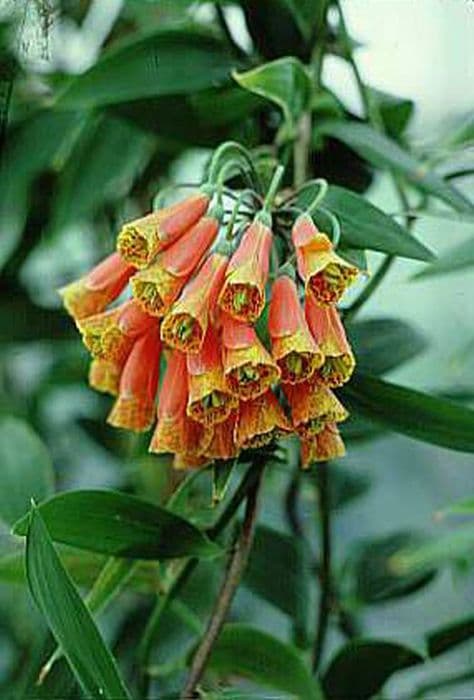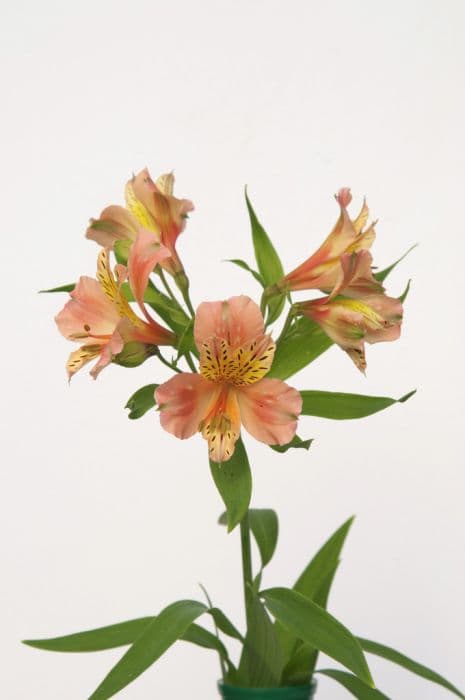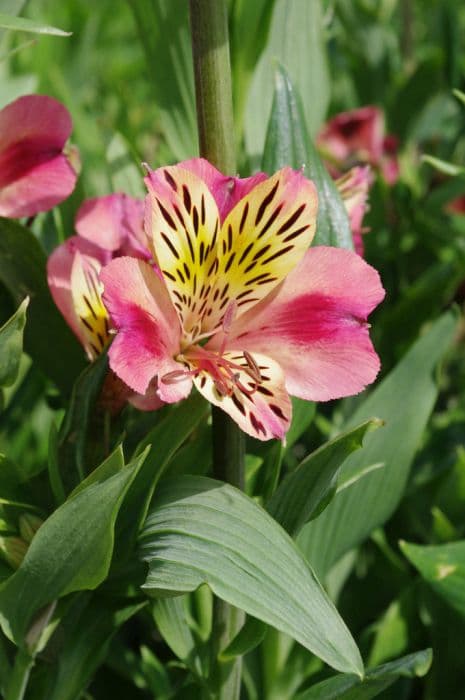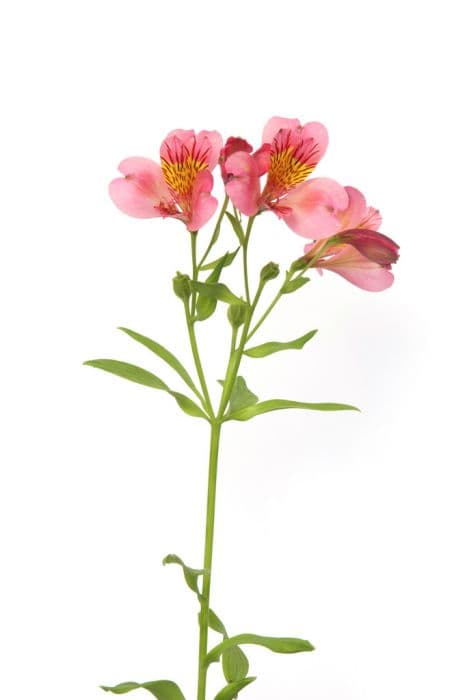Climbing Alstroemeria Bomarea multiflora

ABOUT
Bomarea multiflora, commonly known as climbing alstroemeria, is a visually striking plant known for its cascading clusters of vibrant, trumpet-shaped flowers. The blossoms come in an array of vivid colors, often a mix of reds, oranges, yellows, and occasionally with intricate speckles or streaks that add to their ornamental appeal. Each flower has curved petals that flare outwards from a narrow base, displaying a characteristic form that resembles those of its closely related terrestrial cousin, the alstroemeria. The leaves of climbing alstroemeria are narrow and lance-shaped, with a glossy green appearance that provides a lush background for the floral display. They are arranged alternately along the stems, contributing to the plant's overall texture and fullness. The leaves often clasp the stem at the base, and their edges can be smooth or slightly wavy. Tendrils can be found at the tips of the branches, which the plant uses to climb and support itself on surrounding structures or vegetation. These tendrils enable the climbing alstroemeria to reach towards the light, intertwining with other plants or objects, which makes it a popular choice for vertical gardening. The overall impression of Bomarea multiflora is that of a robust and vigorous climber, adorned with spectacular, showy flowers and dense foliage. Its ability to add a vertical element of lushness and color makes it a favored option for both outdoor gardens and as a greenhouse specimen, where its remarkable beauty can be appreciated up close.
About this plant
 Names
NamesFamily
Alstroemeriaceae.
Synonyms
Tropa loca, Flor de coral, Climbing Alstroemeria.
Common names
Alstroemeria multiflora.
 Toxicity
ToxicityTo humans
Bomarea multiflora, commonly known as climbing Alstroemeria, has not been widely reported to be toxic to humans. However, as a general precaution, it is not advisable to ingest any part of ornamental plants due to the potential for unknown toxicity or allergic reactions. If you suspect poisoning from any plant, seek medical attention promptly.
To pets
Climbing Alstroemeria is not typically known to be toxic to pets, but the general lack of data suggests caution. As with humans, pets should not ingest plants that are not confirmed to be safe, as there could always be individual reactions or undiscovered toxic compounds. If a pet shows signs of distress after consuming any part of a plant, contact a veterinarian immediately.
 Characteristics
CharacteristicsLife cycle
Perennials
Foliage type
Evergreen
Color of leaves
Green
Flower color
Mixed
Height
6-10 feet (1.8-3 meters)
Spread
2-3 feet (0.6-0.9 meters)
Plant type
Climber
Hardiness zones
8
Native area
South America
Benefits
 General Benefits
General Benefits- Decorative Appeal: Bomarea multiflora, also known as Climbing Alstroemeria, adds vibrant colors and exotic beauty to gardens with its strikingly intricate flowers.
- Attracts Pollinators: The plant is known to attract hummingbirds, bees, and other beneficial pollinators that contribute to the health and reproduction of garden ecosystems.
- Vertical Gardening: As a climbing plant, it is perfect for vertical gardening, allowing gardeners with limited space to still enjoy lush foliage and blooming flowers.
- Cultural Significance: In some cultures, Bomarea multiflora is used in traditional ceremonies and as a gift during special occasions, representing friendship and devotion.
- Habitat Support: It provides natural habitat and food source for a variety of fauna, especially in its native regions, and helps in maintaining biodiversity.
- Low Maintenance: The plant generally requires minimal care once established, making it a convenient choice for both novice and experienced gardeners.
- Drought Tolerant: Bomarea multiflora has a level of drought tolerance once established, making it suitable for water-conservation landscapes.
- Seasonal Interest: It blooms from late spring through fall, offering prolonged visual interest and seasonal variation in the garden.
 Medical Properties
Medical Properties- There is currently no recognized medical use or significant evidence supporting the medical properties of Bomarea multiflora.
 Air-purifying Qualities
Air-purifying QualitiesThis plant is not specifically known for air purifying qualities.
 Other Uses
Other Uses- Bomarea multiflora, commonly known as the climbing alstroemeria, can be used as a living curtain to provide privacy in outdoor spaces, thanks to its climbing habit.
- The vibrant flowers of the climbing alstroemeria can be used in floral arrangements to add a splash of color and exotic appeal to bouquets.
- In mild climates, the climbing alstroemeria can be trained along fences to create a decorative and natural fence cover that enhances the aesthetics of garden boundaries.
- The stems of the climbing alstroemeria can be used in artisan crafts for their flexibility and strength, suitable for weaving small decorative objects.
- Bird enthusiasts often cultivate climbing alstroemeria in their gardens to attract hummingbirds and other nectar-feeding birds, creating a lively environment.
- The climbing alstroemeria's ability to climb supports can be harnessed to create green archways or entryways for garden paths and gateways.
- Its bright and colorful blossoms offer photographic opportunities for nature photographers and enthusiasts, enriching the visual content of garden portfolios.
- Because of its extensive root system, climbing alstroemeria can be planted on slopes for soil stabilization and to prevent erosion in certain landscapes.
- Gardeners might use the climbing alstroemeria as a companion plant to create multi-level plant displays, taking advantage of its vertical growth habit.
- Biomimicry artists and designers may study the petals of climbing alstroemeria for inspiration in their work, imitating their patterns and color combinations.
Interesting Facts
 Feng Shui
Feng ShuiBomarea multiflora is not used in Feng Shui practice.
 Zodiac Sign Compitability
Zodiac Sign CompitabilityBomarea multiflora is not used in astrology practice.
 Plant Symbolism
Plant Symbolism- Resilience: Bomarea multiflora, also known as the Climbing Alstroemeria, often thrives in challenging environments which symbolizes its ability to persevere and adapt.
- Endurance: With its robust climbing nature, the Climbing Alstroemeria represents endurance and the capacity to sustain oneself through difficult times.
- Diversity: The variety of colors found in Climbing Alstroemeria blossoms stands for diversity and the richness of combining different elements in harmony.
- Bountifulness: Bomarea multiflora is known for its numerous flowers and therefore it can symbolize abundance and generosity.
 Water
WaterThe Climbing Alstroemeria should be watered regularly, about once a week, providing enough water to keep the soil consistently moist but not waterlogged. During the active growing season in spring and summer, it may require watering twice a week, especially in warmer climates. Approximately one to two gallons per week should suffice, adjusting for rainfall and temperature conditions. Always check the top inch of soil for dryness before watering and reduce the frequency in winter when the plant's growth slows.
 Light
LightClimbing Alstroemeria prefers bright, indirect light but can tolerate some direct morning sun. It thrives in a spot where it receives filtered sunlight for most of the day. Avoid placing it in locations where the hot afternoon sun may scorch the leaves, as this can damage the plant.
 Temperature
TemperatureClimbing Alstroemeria does well in temperatures between 50°F and 80°F; it should not be exposed to temperatures below 30°F as frost can severely damage the plant. The ideal temperature range for active growth is between 60°F and 70°F. It's important to protect the Climbing Alstroemeria from extreme temperatures, both hot and cold, to ensure its health.
 Pruning
PruningPruning the Climbing Alstroemeria is necessary to maintain shape, remove dead or damaged stems, and encourage bushier growth. Prune lightly in early spring or after the main flowering period to promote new blooms. Cut back overgrown stems at this time, and remove any spent flowers to encourage reblooming. Annual or biennial pruning is often enough for this plant.
 Cleaning
CleaningAs needed
 Soil
SoilClimbing Alstroemeria requires well-draining soil enriched with organic matter, a mix of peat, sand, and loam is ideal. Soil pH should be slightly acidic to neutral, around 6.1 to 7.5.
 Repotting
RepottingBomarea multiflora, commonly known as Climbing Alstroemeria, should be repotted every two to three years or when it outgrows its current pot.
 Humidity & Misting
Humidity & MistingClimbing Alstroemeria thrives in moderate to high humidity levels, ideally between 50-70%.
 Suitable locations
Suitable locationsIndoor
Place Climbing Alstroemeria in bright, indirect light indoors.
Outdoor
Plant Climbing Alstroemeria in partial shade outdoors.
Hardiness zone
7-10 USDA
 Life cycle
Life cycleBomarea multiflora, commonly known as the climbing alstroemeria, begins its life cycle as a seed, which upon germination in warm, moist soil, starts to develop a root system and shoots that grow towards the light. The seedling then enters a vegetative stage, growing leaves and stems that are capable of twining and climbing, utilizing nearby structures or plants for support. As the climbing alstroemeria matures, it develops tubers that serve as a nutrient and energy storage that enable it to endure unfavorable conditions. When the plant reaches maturity, it produces clusters of brightly colored, trumpet-shaped flowers that attract pollinators, a reproductive phase that can occur several times throughout the growing season in favorable conditions. After pollination, the flowers develop into capsule-like fruits, which upon ripening, release seeds, completing the reproductive cycle. In colder climates the above-ground parts of the plant may die back in winter, but the tubers remain dormant underground until conditions become suitable for a new growth cycle in the spring.
 Propogation
PropogationPropogation time
Spring-summer
Propogation: Bomarea multiflora, commonly known as the Climbing Alstroemeria, is typically propagated through its tubers. The best time to propagate this plant is in late winter or early spring, just before the growing season begins. To propagate by tubers, carefully dig up the plant and gently separate the tubers from the main clump. Make sure each tuber has at least one eye, similar to a potato, which is a growth point for new shoots. After separation, plant the tubers in well-draining soil at a depth of about 2 to 3 inches (5 to 7.5 centimeters) and water them in. Ensure that the location is one with indirect light and protection from harsh weather. The tubers will develop roots and shoots in the coming weeks, eventually growing into new Climbing Alstroemeria plants.




![Peruvian lily [H.R.H. Princess Alice]](/_next/image?url=https%3A%2F%2Fplants-admin.emdemapps.com%2Fimages%2Fplants%2F%2Fimages%2F604b55e81c8b0.png&w=640&q=75)
![Peruvian lily [Indian summer]](/_next/image?url=https%3A%2F%2Fplants-admin.emdemapps.com%2Fimages%2Fplants%2F%2Fimages%2F604b616bc746b.png&w=640&q=75)
![Peruvian lily [Inticancha Creamy Dark Pink]](/_next/image?url=https%3A%2F%2Fplants-admin.emdemapps.com%2Fimages%2Fplants%2F%2Fimages%2F604b5e98bea7c.png&w=640&q=75)
![Peruvian lily [Inticancha Dark Purple]](/_next/image?url=https%3A%2F%2Fplants-admin.emdemapps.com%2Fimages%2Fplants%2F%2Fimages%2F604b5381bb78f.png&w=640&q=75)
![Peruvian lily [Inticancha Imala]](/_next/image?url=https%3A%2F%2Fplants-admin.emdemapps.com%2Fimages%2Fplants%2F%2Fimages%2F604b619b522ba.png&w=640&q=75)
![Peruvian lily [Inticancha Red]](/_next/image?url=https%3A%2F%2Fplants-admin.emdemapps.com%2Fimages%2Fplants%2F%2Fimages%2F604b5aebac273.png&w=640&q=75)